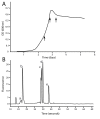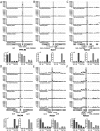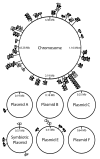Genome-wide detection of predicted non-coding RNAs in Rhizobium etli expressed during free-living and host-associated growth using a high-resolution tiling array
- PMID: 20089193
- PMCID: PMC2881028
- DOI: 10.1186/1471-2164-11-53
Genome-wide detection of predicted non-coding RNAs in Rhizobium etli expressed during free-living and host-associated growth using a high-resolution tiling array
Abstract
Background: Non-coding RNAs (ncRNAs) play a crucial role in the intricate regulation of bacterial gene expression, allowing bacteria to quickly adapt to changing environments. In the past few years, a growing number of regulatory RNA elements have been predicted by computational methods, mostly in well-studied gamma-proteobacteria but lately in several alpha-proteobacteria as well. Here, we have compared an extensive compilation of these non-coding RNA predictions to intergenic expression data of a whole-genome high-resolution tiling array in the soil-dwelling alpha-proteobacterium Rhizobium etli.
Results: Expression of 89 candidate ncRNAs was detected, both on the chromosome and on the six megaplasmids encompassing the R. etli genome. Of these, 11 correspond to functionally well characterized ncRNAs, 12 were previously identified in other alpha-proteobacteria but are as yet uncharacterized and 66 were computationally predicted earlier but had not been experimentally identified and were therefore classified as novel ncRNAs. The latter comprise 17 putative sRNAs and 49 putative cis-regulatory ncRNAs. A selection of these candidate ncRNAs was validated by RT-qPCR, Northern blotting and 5' RACE, confirming the existence of 4 ncRNAs. Interestingly, individual transcript levels of numerous ncRNAs varied during free-living growth and during interaction with the eukaryotic host plant, pointing to possible ncRNA-dependent regulation of these specialized processes.
Conclusions: Our data support the practical value of previous ncRNA prediction algorithms and significantly expand the list of candidate ncRNAs encoded in the intergenic regions of R. etli and, by extension, of alpha-proteobacteria. Moreover, we show high-resolution tiling arrays to be suitable tools for studying intergenic ncRNA transcription profiles across the genome. The differential expression levels of some of these ncRNAs may indicate a role in adaptation to changing environmental conditions.
Figures






Similar articles
-
Stress response regulators identified through genome-wide transcriptome analysis of the (p)ppGpp-dependent response in Rhizobium etli.Genome Biol. 2011;12(2):R17. doi: 10.1186/gb-2011-12-2-r17. Epub 2011 Feb 16. Genome Biol. 2011. PMID: 21324192 Free PMC article.
-
RNA-Seq analysis of the multipartite genome of Rhizobium etli CE3 shows different replicon contributions under heat and saline shock.BMC Genomics. 2014 Sep 8;15(1):770. doi: 10.1186/1471-2164-15-770. BMC Genomics. 2014. PMID: 25201548 Free PMC article.
-
nocoRNAc: characterization of non-coding RNAs in prokaryotes.BMC Bioinformatics. 2011 Jan 31;12:40. doi: 10.1186/1471-2105-12-40. BMC Bioinformatics. 2011. PMID: 21281482 Free PMC article.
-
Biogenesis, Functions, Interactions, and Resources of Non-Coding RNAs in Plants.Int J Mol Sci. 2022 Mar 28;23(7):3695. doi: 10.3390/ijms23073695. Int J Mol Sci. 2022. PMID: 35409060 Free PMC article. Review.
-
Advances in Computational Methodologies for Classification and Sub-Cellular Locality Prediction of Non-Coding RNAs.Int J Mol Sci. 2021 Aug 13;22(16):8719. doi: 10.3390/ijms22168719. Int J Mol Sci. 2021. PMID: 34445436 Free PMC article. Review.
Cited by
-
Riboregulation in Nitrogen-Fixing Endosymbiotic Bacteria.Microorganisms. 2020 Mar 10;8(3):384. doi: 10.3390/microorganisms8030384. Microorganisms. 2020. PMID: 32164262 Free PMC article. Review.
-
Canonical and non-canonical EcfG sigma factors control the general stress response in Rhizobium etli.Microbiologyopen. 2013 Dec;2(6):976-87. doi: 10.1002/mbo3.137. Epub 2013 Oct 28. Microbiologyopen. 2013. PMID: 24311555 Free PMC article.
-
The small regulatory RNA molecule MicA is involved in Salmonella enterica serovar Typhimurium biofilm formation.BMC Microbiol. 2010 Nov 2;10:276. doi: 10.1186/1471-2180-10-276. BMC Microbiol. 2010. PMID: 21044338 Free PMC article.
-
Stress response regulators identified through genome-wide transcriptome analysis of the (p)ppGpp-dependent response in Rhizobium etli.Genome Biol. 2011;12(2):R17. doi: 10.1186/gb-2011-12-2-r17. Epub 2011 Feb 16. Genome Biol. 2011. PMID: 21324192 Free PMC article.
-
Identification and characterization of wheat long non-protein coding RNAs responsive to powdery mildew infection and heat stress by using microarray analysis and SBS sequencing.BMC Plant Biol. 2011 Apr 7;11:61. doi: 10.1186/1471-2229-11-61. BMC Plant Biol. 2011. PMID: 21473757 Free PMC article.
References
-
- Brownlee GG. Sequence of 6S RNA of E. coli. Nat New Biol. 1971;229:147–149. - PubMed
-
- Gottesman S. Micros for microbes: non-coding regulatory RNAs in bacteria. Trends Genet. 2005;21:399–404. - PubMed
-
- Storz G, Altuvia S, Wassarman KM. An abundance of RNA regulators. Annu Rev Biochem. 2005;74:199–217. - PubMed
-
- Vogel J, Sharma CM. How to find small non-coding RNAs in bacteria. Biol Chem. 2005;386:1219–1238. - PubMed
Publication types
MeSH terms
Substances
LinkOut - more resources
Full Text Sources
Molecular Biology Databases
Miscellaneous

